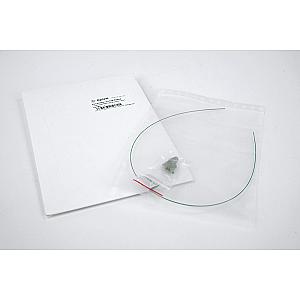The Agilent G1375-87304 capillary is a high-precision connection tube designed for capillary liquid chromatography and nano-flow applications. Made of PEEK and fused silica, this capillary offers an internal diameter of 50 µm and a length of 500 mm. It is equipped with three connectors: two PEEK MLP micro-connectors and one PEEK 10-32 (WF) connector. This product ensures a leak-free connection in low-flow LC systems, while providing optimal compatibility with Agilent 1200 series autosamplers, including the G1377A model.
Capillary G1375-87304 - Perfect Condition





Offer Details
Accessories :
3685
Options :
Agilent G1375-87304 Kapillare Fused silica/PEEK capillary 50 µm, 50 cm
Description
Agilent G1375-87304 capillary: the precision connection solution for capillary LC systems
The Agilent G1375-87304 capillary is an essential component for laboratories using capillary or nano-flow liquid chromatography systems. Designed specifically to integrate seamlessly with the 1200 series autosamplers, including the G1377A Micro Well Plate Autosampler, this capillary ensures optimal performance for applications requiring very low dispersion and minimal dead volume.
This capillary is made from two benchmark materials in the analytical field: PEEK (polyetheretherketone) and fused silica. This unique combination brings together the mechanical flexibility of PEEK and the chromatographic properties of silica, such as low adsorption and excellent chemical resistance. With an internal diameter of 50 microns (0.05 mm), this capillary is perfectly suited to low injection volumes, typical of capillary or nanoLC applications.
Its length of 500 mm ensures optimal connectivity between LC system components while maintaining a minimal connection volume, thus limiting sample dilution and improving chromatographic resolution. Another major advantage of the G1375-87304 is its fitting configuration: two PEEK Microvalve (MLP) fittings at one end (M4, ID 0.8 mm, long version) and a PEEK 10-32 WF (Winged Finger-tight) fitting at the other end. All these fittings are non-swaged, making them easy to install and replace without specialised tools.
The G1375-87304 is fully compatible with capillary liquid chromatography techniques, particularly for analyses where dead volume control and connection stability are essential. It is used in configurations where high injection accuracy is required, particularly with the microvolume injectors fitted to G1377A autosamplers. It can be integrated into a robotic sampling and injection system allowing sample volumes in the order of nanolitres to a few microlitres, while maintaining an extremely low level of dispersion.
The G1375-87304 is recommended for laboratories requiring perfect injection repeatability, maximum cross-contamination reduction and high mechanical and chemical stability. Its role in the overall analytical circuit is crucial, particularly in ensuring perfect sealing under pressure conditions of up to 400 bar, which are characteristic of modern capillary systems.
Features
- Hybrid PEEK/silica design for increased flexibility and chromatographic performance
- Ultra-fine internal diameter (50 µm) ideal for low-volume applications
- 500 mm length for easy integration into capillary LC systems
- Three fittings included for immediate compatibility with Agilent autosamplers
- Non-crimped fittings for easy replacement
- High resistance to organic solvents and pressure conditions up to 400 bar
- Compatible with 1200 series microvolume injectors, including model G1377A
- Low dead volume for significant reduction in sample dispersion
- Easy installation thanks to finger-tight PEEK fittings
Technical Details
- Type of technique: LC (capillary liquid chromatography/nanoLC)
- Internal diameter (ID): 50 µm (0.05 mm)
- Length: 500 mm
- Materials: PEEK / Fused silica (FS)
- Left-hand connector type: MLP PEEK (M4, ID 0.8 mm, long version)
- Right-hand connector type: WF PEEK 10-32 (Swagelok, finger-tight with wing nut)
- Number of fittings supplied: 3 (2x MLP + 1x WF)
- Crimping status of fittings: Uncrimped on both sides
- Application compatibility: Cap-Nano
Compatible Accessories
- 2x Microvalve MLP PEEK fittings (M4, long, ID 0.8 mm)
- 1x PEEK 10-32 WF fitting (winged screw, finger-tight)
- Compatible with:
- 40 µL capillary loops (ref. G1377-87300)
- Seat capillaries (ref. G1367-87316)
- Injector purge kit (ref. G1373A)
- G1377A Autosamplers – Micro Well Plate Autosampler